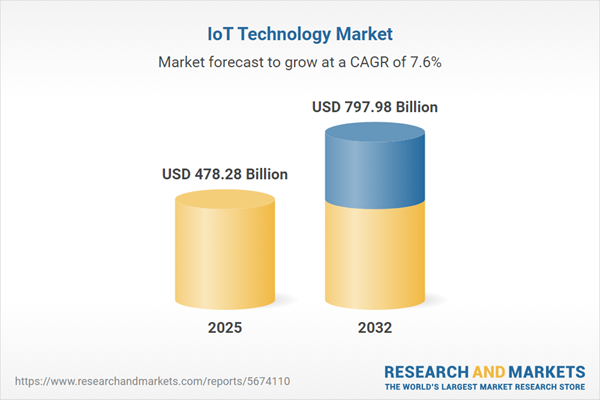Speak directly to the analyst to clarify any post sales queries you may have.
The IoT technology market is rapidly redefining operational models, data intelligence, and competitive advantage across sectors. Senior leaders who prioritize data-driven agility and cross-functional integration are leveraging IoT solutions to adapt to changing digital landscapes and emerging regulatory challenges.
Market Snapshot: IoT Technology Market Growth and Outlook
The IoT technology market grew from USD 444.47 billion in 2024 to USD 478.28 billion in 2025, and it is projected to reach USD 797.98 billion by 2032 with a CAGR of 7.58%. This expansion demonstrates sustained enterprise commitment to connectivity, automation, and seamless data exchange. IoT continues to transform industrial, commercial, and consumer operations by integrating physical assets with digital ecosystems, opening new avenues for efficiency and revenue generation.
Scope & Segmentation: Strategic Coverage Areas
- Component: Hardware (gateways, modules & chips, sensors & actuators), Services (managed services, professional services), Software (analytics & applications, platforms)
- End User Industry: Agriculture (livestock monitoring, precision farming), BFSI (connected banking, insurance telematics), Energy & Utilities (asset monitoring, smart grid, smart metering), Healthcare (hospital asset management, remote patient monitoring, telehealth), Manufacturing (automotive, chemicals, electronics, food & beverage, pharmaceuticals), Retail (customer analytics, in-store management, supply chain optimization), Smart Cities (public safety, traffic management, waste management), Transportation & Logistics (cold chain monitoring, fleet management, warehouse management)
- Connectivity: Cellular (2G/3G, 4G/5G), LPWAN (LoRaWAN, NB-IoT, Sigfox), Satellite (GEO, LEO, MEO), Short Range Wireless (Bluetooth, RFID, Wi-Fi, Zigbee), Wired (Ethernet, power line communication)
- Deployment: Cloud (private cloud, public cloud), Hybrid (integrated solutions), On Premises (enterprise data center)
- Region: Americas (United States, Canada, Mexico, Brazil, Argentina, Chile, Colombia, Peru), Europe, Middle East & Africa (United Kingdom, Germany, France, Russia, Italy, Spain, Netherlands, Sweden, Poland, Switzerland, United Arab Emirates, Saudi Arabia, Qatar, Turkey, Israel, South Africa, Nigeria, Egypt, Kenya), Asia-Pacific (China, India, Japan, Australia, South Korea, Indonesia, Thailand, Malaysia, Singapore, Taiwan)
- Key Companies: Amazon.com, Inc., Microsoft Corporation, Cisco Systems, Inc., International Business Machines Corporation, Alphabet Inc., Intel Corporation, Huawei Technologies Co., Ltd., Hewlett Packard Enterprise Company, Siemens AG, SAP SE
Key Takeaways for Decision-Makers
- Sensor and connectivity innovation are enabling seamless integration of IoT across large-scale industrial, commercial, and municipal environments.
- Artificial intelligence and machine learning integration within IoT solutions is driving automation, predictive maintenance, and adaptive security, aligning technology deployments more closely with strategic business goals.
- End-user industries demonstrate varying adoption drivers, with agriculture, healthcare, manufacturing, and utilities each leveraging IoT to optimize specific operational processes and elevate service delivery models.
- Vendors are fostering new business models by combining hardware, analytics, and cloud services, while interoperability standards and managed services are reducing complexity for large-scale implementations.
- Strategic regional priorities shape market uptake, with North America, Europe, Asia-Pacific, and emerging regions each focusing on differentiated applications, regulatory frameworks, and technology readiness.
Tariff Impact: Supply Chain Adaptation in the IoT Market
The introduction of new United States tariff measures in 2025 has prompted market participants to restructure supply chains. Companies are mitigating cost pressures by diversifying suppliers, optimizing designs, and relocating production closer to end markets. Initiatives include vendor base expansion, assembly center establishment, and materials substitution to maintain operational resilience under evolving trade terms.
Methodology & Data Sources for Market Insight
This report leverages secondary research from peer-reviewed literature, white papers, and regulatory documents, enriched with primary interviews across hardware, software, and end-user segments. Quantitative and qualitative analyses were validated using scenario modeling and expert peer review to ensure accuracy and strategic relevance.
Why This Report Matters to Senior Leaders
- Enables informed investment by illuminating trends and competitive positioning across technology stacks, industry verticals, and global regions.
- Equips executives with actionable strategies to enhance data security, interoperability, and risk mitigation in complex IoT ecosystems.
- Supports tailored roadmap development by detailing regulatory, technological, and regional market drivers critical to sustained IoT leadership.
Conclusion
IoT technology is shaping the future of digital transformation through connected intelligence, edge innovation, and strategic supply chain adaptation. Forward-thinking executives who harmonize technology investments with business priorities will secure lasting advantages in an interconnected world.
Additional Product Information:
- Purchase of this report includes 1 year online access with quarterly updates.
- This report can be updated on request. Please contact our Customer Experience team using the Ask a Question widget on our website.
Table of Contents
3. Executive Summary
4. Market Overview
7. Cumulative Impact of Artificial Intelligence 2025
Companies Mentioned
The companies profiled in this IoT Technology market report include:- Amazon.com, Inc.
- Microsoft Corporation
- Cisco Systems, Inc.
- International Business Machines Corporation
- Alphabet Inc.
- Intel Corporation
- Huawei Technologies Co., Ltd.
- Hewlett Packard Enterprise Company
- Siemens AG
- SAP SE
Table Information
| Report Attribute | Details |
|---|---|
| No. of Pages | 181 |
| Published | November 2025 |
| Forecast Period | 2025 - 2032 |
| Estimated Market Value ( USD | $ 478.28 Billion |
| Forecasted Market Value ( USD | $ 797.98 Billion |
| Compound Annual Growth Rate | 7.5% |
| Regions Covered | Global |
| No. of Companies Mentioned | 11 |









